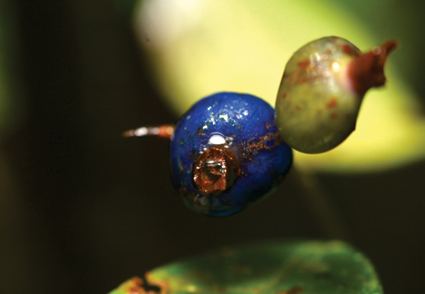Abstract
Here we propose a lectotypification and a new name for the Brazilian Psychotria dusenii Standl. to be treated under Palicourea Aubl. The name Psychotria dusenii sensu Standley is illegitimate because it was previously assigned to an African Psychotria L. species described by K. Schumann. The new name proposed is Palicourea roseocalycina Torres-Leite.
References
- Andersson, L. (2002) Relationships and generic circumscriptions in the Psychotria complex (Rubiaceae, Psychotrieae). Systematics and Geography of Plants 72: 167–202.
- Aublet, J.B.C.F. (1775) Histoire des Plantes de la Guiane Françoise 1: 172–173, pl. 66.
- Barrabé, L., Mouly, A. & Florence, J. (2013) Psychotriae (Rubiaceae) neocaledonicarum specierum nomenclator. Adansonia sér. 3 35 (2): 281–357. https://doi.org/10.5252/a2013n2a6
- Bentham, G. (1849) Niger flora; or, An enumeration of the plants of western tropical Africa. Hyppolyte Bailliere, London, 588 pp. https://doi.org/10.5962/bhl.title.594
- Bremer, B. & Eriksson, O. (2009) Time tree of Rubiaceae: phylogeny and dating the family, subfamily, and tribes. International Journal of Plant Science 170: 766–793. https://doi.org/10.1086/599077
- BFG (2018) The Brazil Flora Group. Brazilian Flora 2020: Innovation and collaboration to meet Target 1 of the Global Strategy for Plant Conservation (GSPC). Rodriguesia 69: 1513–1527. https://doi.org/10.1590/2175-7860201869402
- BFG (2021) Brazilian Flora 2020: Leveraging the power of a collaborative scientific network. Taxon 71: 178–198. https://doi.org/10.1002/tax.12640
- Carmo, J.A.M. & Simões, A.O. (2017) Rubiaceae no Município de Camanducaia, Serra da Mantiqueira, Minas Gerais: sinopse e chave interativa. Rodriguésia 68 (4): 1411–1429. https://doi.org/10.1590/2175-7860201768421
- Govaerts (2024) Psychotria alegre in GBIF Secretariat. GBIF Backbone Taxonomy. https://doi.org/10.15468/39omei
- Govaerts, R., Ruhsam, M., Andersson, L., Robbrecht, E., Bridson, D., Davis, A., Schanzer, I. & Sonké, B. (2024) World Checklist of Rubiaceae. Facilitated by the Royal Botanic Gardens, Kew. [http://www.kew.org/wcsp]
- IPNI (2024) International Plant Names Index. The Royal Botanic Gardens, Kew, Harvard University Herbaria & Libraries and Australian National Botanic Gardens. Available from: http://www.ipni.org (accessed 17 January 2022)
- Jung-Mendaçolli, S.L. (2007) Rubiaceae. In: Wanderley, M.G.L., Shepherd, G.J., Melhem, T.S. & Giulietti, A.M. (Eds.) Flora fanerogâmica do estado de São Paulo, 5. Instituto de Botânica, São Paulo, pp. 259–460.
- Linnaeus, C. (1759) Systema Naturae. Imprensis Laurentii Salvii, Holmiae, 1384 pp.
- Lorence, D.H. & Taylor, C.M. (2012) Rubiaceae. Flora Mesoamericana 4 (2): 1–563.
- Mueller Argoviensis, J. (1881) Rubiaceae. In: Martius, C.P.F., Eichler, A.W. & Urban, I. (Eds.) Flora brasiliensis, 6. Lipsiae, Fleischer, pp. 1–470, tab. 1–67.
- Nepokroeff, M., Bremer, B. & Sytsma, K.L. (1999) Reorganization of the Genus Psychotria and Tribe Psychotrieae (Rubiaceae) Inferred from ITS and rbcL Sequence Data. Systematic Botany 24: 5–27. https://doi.org/10.2307/2419383
- Razafimandimbison, S.G., Taylor, C.M., Wikström, N., Pailler, T., Khodabandeh, A. & Bremer, B. (2014) Phylogeny and generic limits in the sister tribes Psychotrieae and Palicoureeae (Rubiaceae): Evolution of schizocarps in Psychotria and origins of bacterial leaf nodules of the Malagasy species. American Journal of Botany 101 (7): 1–25. https://doi.org/10.3732/ajb.1400076
- Robbrecht, E. & Manen, J.F. (2006) The major evolutionary lineages of the coffee Family (Rubiaceae, angiosperms). Combined analysis (nDNA and cpDNA) to infer the position of Coptosapelta and Luculia, and supertree construction based on rbcL, rps16, trnL-trnF and atpB-rbcL data. A new classification in two subfamilies, Cinchonoideae and Rubioideae. Systematics and Geography of Plants 76: 85–145.
- Schumann, K. (1903) Rubiaceae africanae. Botanische Jahrbücher fur Systematik, Pflanzengeschichte und Pflanzengeographie 2: 333–384.
- Sedio, B.E., Wright, S.J. & Dick, C.W. (2012) Trait evolution and the coexistence of a species swarm in the tropical forest understorey. Journal of Ecology 100: 1183–1193. https://doi.org/10.1111/j.1365-2745.2012.01993.x
- Sedio, B.E., Paul, JR., Taylor, C.M. & Dick, C.W. (2013) Fine-scale niche structure of Neotropical forests reflects a legacy of the Great American Biotic Interchange. Nature Communications 4: 2317. https://doi.org/10.1038/ncomms3317
- SiBBr (2024) Psychotria alegre in Ficha de Espécies do Sistema de Informação sobre a Biodiversidade Brasileira. Available from: https://ferramentas.sibbr.gov.br/ficha/bin/view/especie/psychotria_alegre (accessed 17 January 2022)
- Standley, P.C. (1931) Studies of American plants—V. Field Museum of Natural History Publication 294. Botanical Series VIII (5). Field Museum of Natural History, Chicago, Ill, 398 pp. https://doi.org/10.5962/bhl.title.3827
- Steyermark, J.A. (1972) Rubiaceae. In: Maguire, B. (Ed.) The Botany of the Guayana Highland—Part IX. Memoirs of The New York Botanical Garden, pp. 227–832.
- Taylor, C.M. (1997) Conspectus of the Genus Palicourea (Rubiaceae: Psychotrieae) with the Description of Some New Species from Ecuador and Colombia. Annals of the Missouri Botanical Garden 84 (2): 224–262. https://doi.org/10.2307/2400003
- Taylor, C.M. (2024) Selected Rubiaceae Tribes and Genera. Palicourea Aubl. Tropicos.org. Missouri Botanical Garden. Available from: http://legacy.tropicos.org/Name/40000063?projectid=34 (accessed 10 January 2022)
- Tropicos.org (2024) Missouri Botanical Garden. Available from: https://tropicos.org (accessed 17 January 2022)
- Thiers, B. (2024 [continuously updated]) Index Herbariorum, A global directory of public herbaria and associated staff. New York Botanical Garden’s Virtual Herbarium. Available from: http://sweetgum.nybg.org/ih/ (accessed 31 January 2022)
- Turland, N.J., Wiersema, J.H., Barrie, F.R., Greuter, W., Hawksworth, D.L., Herendeen, P.S., Knapp, S., Kusber, W.-H., Li, D.-Z., Marhold, K., May, T.W., McNeill, J., Monro, A.M., Prado, J., Price, M.J. & Smith, G.F. (2018) International Code of Nomenclature for algae, fungi, and plants (Shenzhen Code) Regnum Vegetabile 159. Koeltz Botanical Books, Glashütten, 254 pp. https://doi.org/10.12705/Code.2018
- Vellozo, J.M. da C. (1825) Florae Fluminensis, Descriptionum plantarum parectura Fluminensi sponte mascentium liber primus ad systema sexuale concinnatus 66: 2, t. 30.
- WCSP (2024) World Checklist of Selected Plant Families. Royal Botanic Gardens, Kew, U.K. Available from: http://wcsp.science.kew.org (accessed 16 January 2022)


